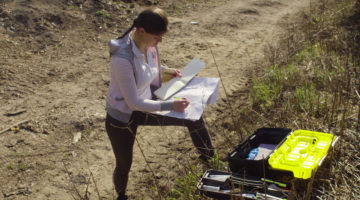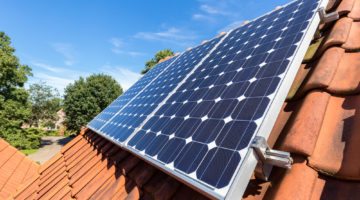
What is solar thermal?
Solar thermal (also known as solar heating) harnesses the energy provided by the sun to provide thermal energy to heat water. The hot water produced by the solar heating can be used to supplement your domestic hot water (although the temperature might need to be topped up by a boiler), larger stores of water (like swimming pools), underfloor heating, and for space heating/cooling.
Unlike a solar photovoltaic cell array, which is designed to produce electricity, a solar heating system is designed simply to produce heat. A well-designed solar heating system will provide approximately 55% of your annual domestic hot water requirement. However, as it is reliant on the sun, your solar heating system will produce more heat in the summer months.
Types of solar thermal system
Solar heating systems all have a few components in common: a solar collector, insulated heat transport piping and heat storage. More complex systems also have electronic controls and freeze-prevention mechanisms (when situated in colder climates). There are three main types of solar collectors:
1. Flat panel solar collectors
These are the most common type of solar heating technology and consist of a box with a piece of glass on the top and a dark absorber plate on the bottom. Sunlight passes through the glazing on the top of the box, heating up the absorber plate and converting the solar energy into thermal energy. Copper pipes are attached on the top of the absorber plates, and the liquid flowing through these pipes absorbs the heat, which is then pumped away and stored until it is needed in the house.
2. Evacuated tube solar collectors
The evacuated tube systems tend to be more efficient, especially in cold or cloudy climates; however their advanced design makes them more expensive. These solar collectors consist of rows of parallel, transparent glass tubes. Each tube contains an absorber assembly and the entire tube is evacuated of any air (so it operates within a vacuum). The sunlight enters the glass tubes and hits the absorber assembly where it is absorbed. As this is operating within a vacuum, heat does not travel back from the absorber to the glass, so these are more efficient. A fluid transfers the heat from the absorber assembly through to the storage tank, where it can be used.
The two major advantages of evacuated tube collectors are that they can produce warmer water (so you will not need to supplement the temperature with a boiler) and they can also produce more hot water than flat-panelled solar collectors.
3. Plastic collectors
These are the cheapest type of solar collector and consist of black plastic pipe treated to withstand UV degradation. Hot water is simply pumped through the black plastic pipes, where it warms up (as the plastic absorbs the suns energy). Plastic collectors are most susceptible to ambient temperatures as there is no insulation in place, so if the outside temperature is cold, very little heat will be produced.
These are an ideal solution for swimming pools though, as they amplify the effects of the weather and its seasons. For example, most swimming pools are used in the summer, so installing plastic collectors will allow you to use the pool sooner in the year, and it will keep the temperature consistently higher.
Things to consider before installing a solar thermal heating system
As with solar photovoltaic cells, solar heating technologies require sunlight, so ideally you would install the technology on a south-facing roof that receives sunlight for most of the day to maximise the benefits. Likewise, the amount of heat you can produce is directly proportional to the amount of installed surface area you have; therefore if you only have a small roof, then this technology may not be appropriate.
In addition, you will produce more hot water in the summer, as the energy from the sun is more intense at this time, therefore you may well have to supplement the temperature of the water in the winter using a boiler. To boost the system, your boiler must be compatible with your solar heating system, but currently most combi or CHP boilers are not compatible. It is therefore very important that you check with your installer before undergoing any works.
If you live in much colder climates you may need to have some sort of antifreeze within your system (when water freezes it turns to ice it expands, potentially causing cracks in the pipes).
If you live in a listed building please note the restrictions. Like with many green technologies, it is worth contacting the local planning office to get permission to place the panels, to save yourself problems further down the line.
Installing solar thermal normally requires a new hot water tank
For many of us with old heat-only boilers, we have a hot water tank hidden away in the airing cupboard. Typically these hot water tanks are heated by a boiler and were purpose-built.
Since the introduction of the RHI, there has been a huge increase in the number of people installing solar thermal in their homes.
If you decide to install solar thermal in your home you will need a hot water tank to store the hot water produced from your collector – the problem though, is that you can’t plumb one of these systems into the older hot water tanks that are historically found with boilers.
Twin coil cylinders
The reason for this is that inside the hot water tank there needs to be a separate coil for each ‘hot water source’. In this case you would need a coil for the solar thermal and one for the hot water. Normally in a residential solar store (i.e. a hot water tank with a solar coil), the solar is connected to the lower coil and the boiler (or main heating source) is connected to the top coil.
Solar coils are much larger than traditional boiler coils because they need a far bigger surface area to transfer their heat into the water compared to a boiler. The reason is that the hot water travelling through the solar thermal coil is at a much lower temperature than the water travelling through a boiler coil.
As a guide, the surface area of a solar thermal coil needs to be in excess of 1.5m2, while a boiler coil can be as little as 0.6m2 – this increased surface area maximises the opportunity for heat transfer and is a must based on the lower water temperature flowing through the coil.
If you cast your mind back to your GCSE science, you will know that heat rises and therefore within a hot water tank, the water at the top of the tank is far warmer than the bottom of the tank.
In a solar thermal store, it is important that this temperature differential is maximised and this is achieved by making the hot water tank rather large and tall. So while the top of the tank could achieve temperatures of 600C plus, the water at the bottom of the tank might be as low as 150C degrees. What this means is that even if the solar thermal is only producing water to 200C degrees, it will still contribute to the hot water demand of the property.
Storing the hot water you produce on sunny days
Since the hot water tanks used for solar thermal systems tend to be big, they tend to be able to store far more hot water than is actually required by most families that install one of them. Since solar thermal is intermittent, (i.e. it produces much more hot water when the sun is shining), this oversized heat tank allows you to store the hot water; thereby taking advantage of favourable conditions a day or two later to help minimise the need to use the boiler.
Maximising return on your investment
The Renewable Heat Incentive (RHI) is now up and running, which works in a similar way to the Feed-in Tariff, rewarding you for any hot water you produce from renewable sources. You can find all the information you need about the RHI on our page here.
Benefits
- Solar water heating will provide hot water throughout the year, although less so in winter.
- Once you have installed the equipment, it provides a free source of hot water.
Limitations
- All solar technologies are reliant on the sun shining; hot water will not be produced at night.
- The maximum water temperature that can be achieved via solar heating is significantly lower than that achieved with gas or electricity-based water heaters.
Cost
- The cost of installing a solar hot water system ranges from approximately £1,500 for a DIY system, to £2,000-£5,000 for a commercially installed system. These prices however, are dependent on the size of the system. The savings resulting from the installation will be approximately £50 – £90 per year.
Installing Solar Thermal
Interested in installing a solar thermal system at home? We have scoured the country for the best tradespeople, so that we can make sure we only recommend those we really trust.
If you would like us to find you a local installer to help install a solar thermal system in your home, just fill in the form below and we will be in touch shortly!












Thanks for very good info. I have a flat roof I could use but nowhere indoors I would put a tall water cylinder. Would putting an insulated one outside but next to the boiler be not worthwhile.